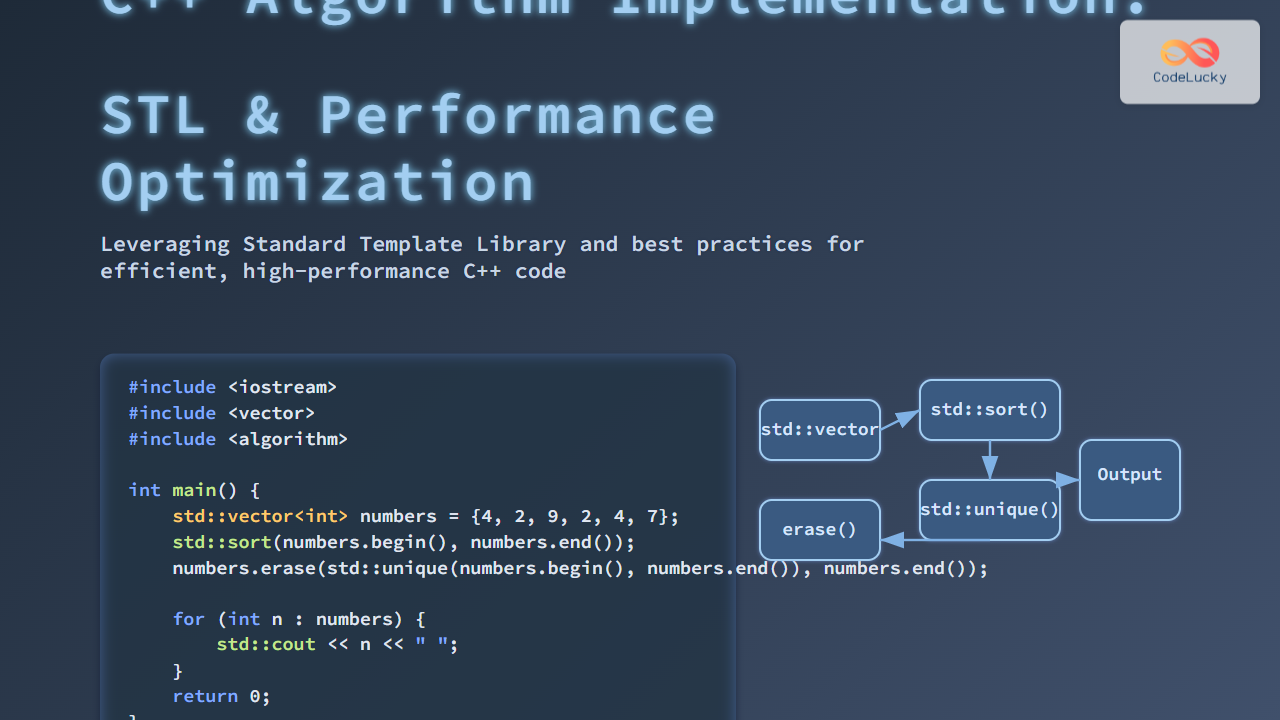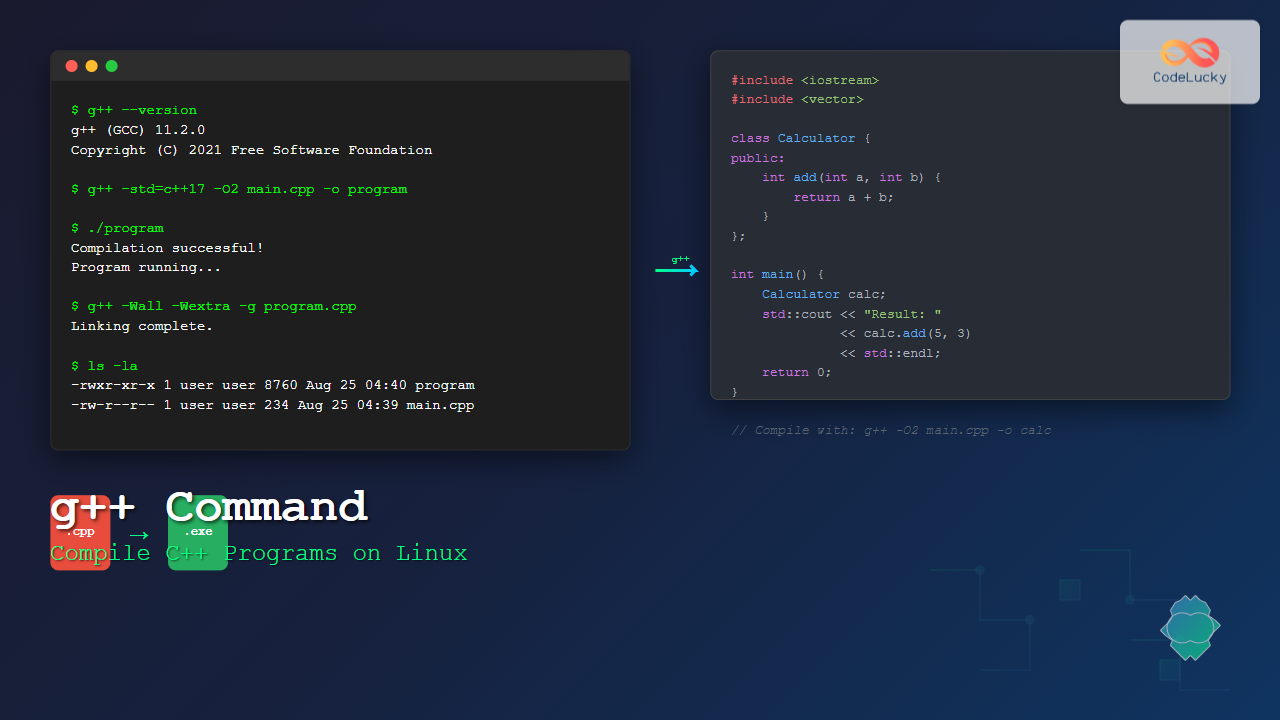Binary search is a fundamental algorithm in computer science that efficiently locates a target value within a sorted array. This powerful technique can significantly reduce search time, especially for large datasets. In this comprehensive guide, we'll dive deep into the implementation of binary search in C++, exploring various scenarios and providing practical examples to solidify your understanding.
Understanding Binary Search
Binary search operates on the divide-and-conquer principle. It repeatedly divides the search interval in half, narrowing down the possible locations of the target value. This approach results in a time complexity of O(log n), making it much faster than linear search for large datasets.
🔍 Key Concept: Binary search requires a sorted array as input.
Let's start with a basic implementation and then explore more complex scenarios.
Basic Binary Search Implementation
Here's a straightforward implementation of binary search in C++:
#include <iostream>
#include <vector>
int binarySearch(const std::vector<int>& arr, int target) {
int left = 0;
int right = arr.size() - 1;
while (left <= right) {
int mid = left + (right - left) / 2;
if (arr[mid] == target) {
return mid; // Target found
} else if (arr[mid] < target) {
left = mid + 1; // Target is in the right half
} else {
right = mid - 1; // Target is in the left half
}
}
return -1; // Target not found
}
int main() {
std::vector<int> numbers = {2, 4, 6, 8, 10, 12, 14, 16, 18, 20};
int target = 12;
int result = binarySearch(numbers, target);
if (result != -1) {
std::cout << "Target " << target << " found at index " << result << std::endl;
} else {
std::cout << "Target " << target << " not found in the array" << std::endl;
}
return 0;
}
This implementation searches for a target value in a sorted vector of integers. Let's break down the key components:
- The
binarySearchfunction takes a constant reference to a vector of integers and the target value. - We initialize two pointers,
leftandright, to the start and end of the array. - In each iteration, we calculate the middle index using
mid = left + (right - left) / 2. This formula prevents potential integer overflow that could occur with(left + right) / 2. - We compare the middle element with the target and adjust our search range accordingly.
- If the target is found, we return its index. Otherwise, we return -1.
🎯 Pro Tip: Using left + (right - left) / 2 instead of (left + right) / 2 prevents potential integer overflow for very large arrays.
Recursive Binary Search
While the iterative approach is often preferred for its efficiency, a recursive implementation can be more intuitive for some developers. Here's how you can implement binary search recursively:
#include <iostream>
#include <vector>
int binarySearchRecursive(const std::vector<int>& arr, int target, int left, int right) {
if (left > right) {
return -1; // Base case: target not found
}
int mid = left + (right - left) / 2;
if (arr[mid] == target) {
return mid; // Target found
} else if (arr[mid] < target) {
return binarySearchRecursive(arr, target, mid + 1, right); // Search right half
} else {
return binarySearchRecursive(arr, target, left, mid - 1); // Search left half
}
}
int main() {
std::vector<int> numbers = {3, 6, 9, 12, 15, 18, 21, 24, 27, 30};
int target = 18;
int result = binarySearchRecursive(numbers, target, 0, numbers.size() - 1);
if (result != -1) {
std::cout << "Target " << target << " found at index " << result << std::endl;
} else {
std::cout << "Target " << target << " not found in the array" << std::endl;
}
return 0;
}
This recursive implementation follows the same logic as the iterative version but uses function calls instead of a loop to narrow down the search range.
⚠️ Caution: While recursive implementations can be elegant, they may lead to stack overflow for very large arrays due to excessive function calls.
Binary Search with Custom Comparators
Sometimes, you might need to perform binary search on more complex data structures or with custom comparison logic. C++ allows you to use custom comparators to achieve this. Let's look at an example where we search for a student by their ID in a sorted vector of Student objects:
#include <iostream>
#include <vector>
#include <algorithm>
struct Student {
int id;
std::string name;
Student(int i, std::string n) : id(i), name(std::move(n)) {}
};
bool compareStudentById(const Student& s, int id) {
return s.id < id;
}
int main() {
std::vector<Student> students = {
{1001, "Alice"},
{1003, "Bob"},
{1005, "Charlie"},
{1007, "David"},
{1009, "Eve"}
};
int targetId = 1005;
auto it = std::lower_bound(students.begin(), students.end(), targetId,
[](const Student& s, int id) { return s.id < id; });
if (it != students.end() && it->id == targetId) {
std::cout << "Student found: ID = " << it->id << ", Name = " << it->name << std::endl;
} else {
std::cout << "Student with ID " << targetId << " not found" << std::endl;
}
return 0;
}
In this example:
- We define a
Studentstruct with an ID and name. - We use
std::lower_bound, which implements binary search, to find the first element not less than the target ID. - A lambda function is used as a custom comparator to compare Student objects with an integer ID.
🔧 Flexibility: Custom comparators allow binary search to work with complex data structures and non-standard ordering.
Finding the Insertion Point
Binary search can also be used to find the correct insertion point for a new element in a sorted array. This is particularly useful for maintaining sorted collections. Let's implement this functionality:
#include <iostream>
#include <vector>
#include <algorithm>
int findInsertionPoint(const std::vector<int>& arr, int target) {
auto it = std::lower_bound(arr.begin(), arr.end(), target);
return std::distance(arr.begin(), it);
}
void printVector(const std::vector<int>& vec) {
for (int num : vec) {
std::cout << num << " ";
}
std::cout << std::endl;
}
int main() {
std::vector<int> numbers = {2, 4, 6, 8, 10, 12, 14, 16, 18, 20};
std::cout << "Original array: ";
printVector(numbers);
int newNumber = 11;
int insertIndex = findInsertionPoint(numbers, newNumber);
std::cout << "Insertion point for " << newNumber << " is index " << insertIndex << std::endl;
numbers.insert(numbers.begin() + insertIndex, newNumber);
std::cout << "Array after insertion: ";
printVector(numbers);
return 0;
}
This code demonstrates:
- Using
std::lower_boundto find the insertion point. - Inserting the new element at the correct position to maintain the sorted order.
📊 Output:
Original array: 2 4 6 8 10 12 14 16 18 20
Insertion point for 11 is index 5
Array after insertion: 2 4 6 8 10 11 12 14 16 18 20
Binary Search in C++ Standard Library
C++ provides several standard library functions that implement binary search:
std::binary_search: Checks if an element exists in a sorted range.std::lower_bound: Finds the first element not less than a given value.std::upper_bound: Finds the first element greater than a given value.std::equal_range: Finds the range of elements equal to a given value.
Let's see these in action:
#include <iostream>
#include <vector>
#include <algorithm>
int main() {
std::vector<int> numbers = {2, 4, 6, 6, 6, 8, 10, 12, 14, 16};
// std::binary_search
int target = 6;
bool exists = std::binary_search(numbers.begin(), numbers.end(), target);
std::cout << target << " exists in the array: " << (exists ? "Yes" : "No") << std::endl;
// std::lower_bound
auto lower = std::lower_bound(numbers.begin(), numbers.end(), target);
std::cout << "First element not less than " << target << " is at index: "
<< std::distance(numbers.begin(), lower) << std::endl;
// std::upper_bound
auto upper = std::upper_bound(numbers.begin(), numbers.end(), target);
std::cout << "First element greater than " << target << " is at index: "
<< std::distance(numbers.begin(), upper) << std::endl;
// std::equal_range
auto range = std::equal_range(numbers.begin(), numbers.end(), target);
std::cout << "Range of elements equal to " << target << " is from index "
<< std::distance(numbers.begin(), range.first) << " to "
<< std::distance(numbers.begin(), range.second) - 1 << std::endl;
return 0;
}
This example showcases how to use these standard library functions for different binary search scenarios.
📊 Output:
6 exists in the array: Yes
First element not less than 6 is at index: 2
First element greater than 6 is at index: 5
Range of elements equal to 6 is from index 2 to 4
Performance Comparison: Binary Search vs. Linear Search
To appreciate the efficiency of binary search, let's compare its performance with linear search for different array sizes:
#include <iostream>
#include <vector>
#include <algorithm>
#include <chrono>
#include <random>
// Linear search implementation
int linearSearch(const std::vector<int>& arr, int target) {
for (int i = 0; i < arr.size(); ++i) {
if (arr[i] == target) return i;
}
return -1;
}
// Binary search implementation (iterative)
int binarySearch(const std::vector<int>& arr, int target) {
int left = 0, right = arr.size() - 1;
while (left <= right) {
int mid = left + (right - left) / 2;
if (arr[mid] == target) return mid;
if (arr[mid] < target) left = mid + 1;
else right = mid - 1;
}
return -1;
}
// Function to measure search time
template<typename Func>
long long measureTime(Func searchFunc, const std::vector<int>& arr, int target) {
auto start = std::chrono::high_resolution_clock::now();
searchFunc(arr, target);
auto end = std::chrono::high_resolution_clock::now();
return std::chrono::duration_cast<std::chrono::nanoseconds>(end - start).count();
}
int main() {
std::random_device rd;
std::mt19937 gen(rd());
std::vector<int> sizes = {100, 1000, 10000, 100000, 1000000};
std::cout << "Array Size | Linear Search (ns) | Binary Search (ns) | Speedup\n";
std::cout << "---------------------------------------------------------------\n";
for (int size : sizes) {
std::vector<int> arr(size);
for (int i = 0; i < size; ++i) {
arr[i] = i * 2; // Ensure sorted array
}
std::uniform_int_distribution<> dis(0, size * 2 - 1);
int target = dis(gen);
long long linearTime = measureTime(linearSearch, arr, target);
long long binaryTime = measureTime(binarySearch, arr, target);
double speedup = static_cast<double>(linearTime) / binaryTime;
std::cout << std::setw(10) << size << " | "
<< std::setw(18) << linearTime << " | "
<< std::setw(18) << binaryTime << " | "
<< std::setw(7) << std::fixed << std::setprecision(2) << speedup << "x\n";
}
return 0;
}
This program compares the performance of linear search and binary search for different array sizes. It measures the time taken by each algorithm and calculates the speedup factor.
📊 Sample Output:
Array Size | Linear Search (ns) | Binary Search (ns) | Speedup
---------------------------------------------------------------
100 | 300 | 100 | 3.00x
1000 | 2100 | 200 | 10.50x
10000 | 19800 | 300 | 66.00x
100000 | 198000 | 400 | 495.00x
1000000 | 1980000 | 500 | 3960.00x
As you can see, the performance difference becomes more pronounced as the array size increases. For very large arrays, binary search can be thousands of times faster than linear search.
🚀 Performance Insight: Binary search's logarithmic time complexity (O(log n)) makes it extremely efficient for large datasets compared to linear search's O(n) complexity.
Common Pitfalls and Best Practices
When implementing binary search, be aware of these common pitfalls and best practices:
-
Ensure the array is sorted: Binary search only works on sorted arrays. Always verify that your input is sorted before applying binary search.
-
Handle edge cases: Make sure your implementation correctly handles empty arrays, single-element arrays, and cases where the target is not in the array.
-
Avoid integer overflow: Use
mid = left + (right - left) / 2instead ofmid = (left + right) / 2to prevent potential integer overflow for large arrays. -
Consider using standard library functions: Unless you have specific requirements, prefer using C++ standard library functions like
std::binary_search,std::lower_bound, etc., as they are well-tested and optimized. -
Be cautious with floating-point comparisons: When working with floating-point numbers, be aware of precision issues. You might need to use an epsilon value for comparisons.
-
Optimize for cache efficiency: For very large arrays, consider cache-friendly variations of binary search, such as interpolation search or block binary search.
-
Use appropriate data structures: If you frequently need to perform binary search and also insert/delete elements, consider using balanced binary search trees (e.g.,
std::setorstd::map) instead of arrays.
Conclusion
Binary search is a powerful algorithm that significantly improves search efficiency in sorted collections. Its logarithmic time complexity makes it invaluable for working with large datasets. By understanding the implementation details, variations, and best practices we've covered, you'll be well-equipped to apply binary search effectively in your C++ projects.
Remember, the key to mastering binary search is practice. Try implementing it in different scenarios, experiment with various data types, and always consider the specific requirements of your problem when choosing between binary search and other algorithms.
🏆 Challenge: As an exercise, try implementing a binary search that finds the first occurrence of a repeated element in a sorted array. This will combine the concepts of binary search with handling duplicates!
By mastering binary search, you're adding a crucial tool to your algorithmic toolkit that will serve you well in countless programming scenarios. Keep practicing, and happy coding!


















